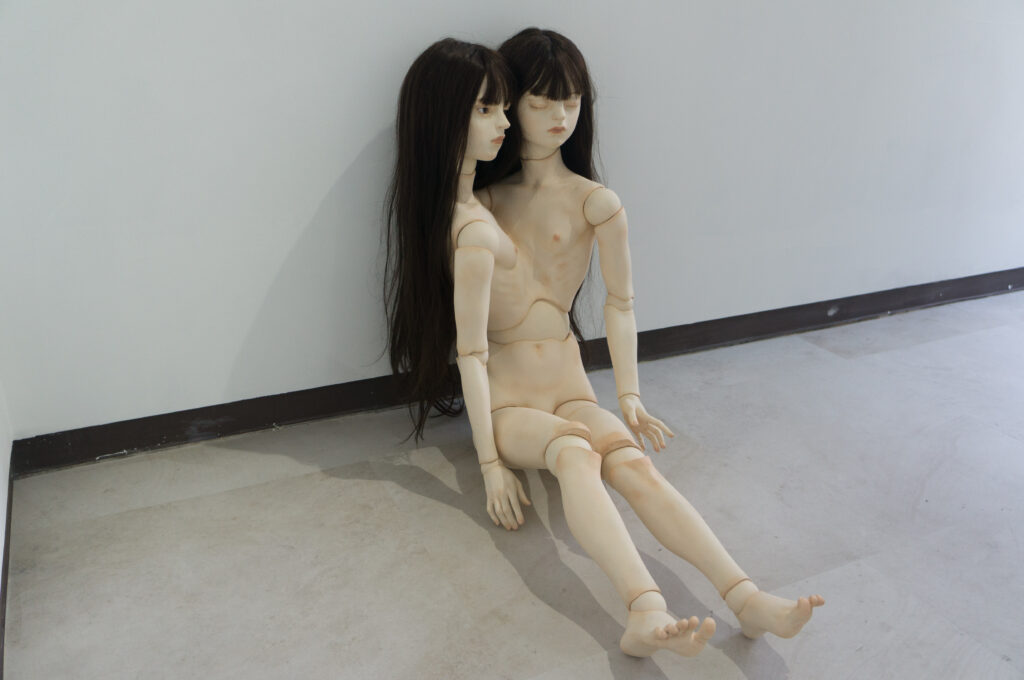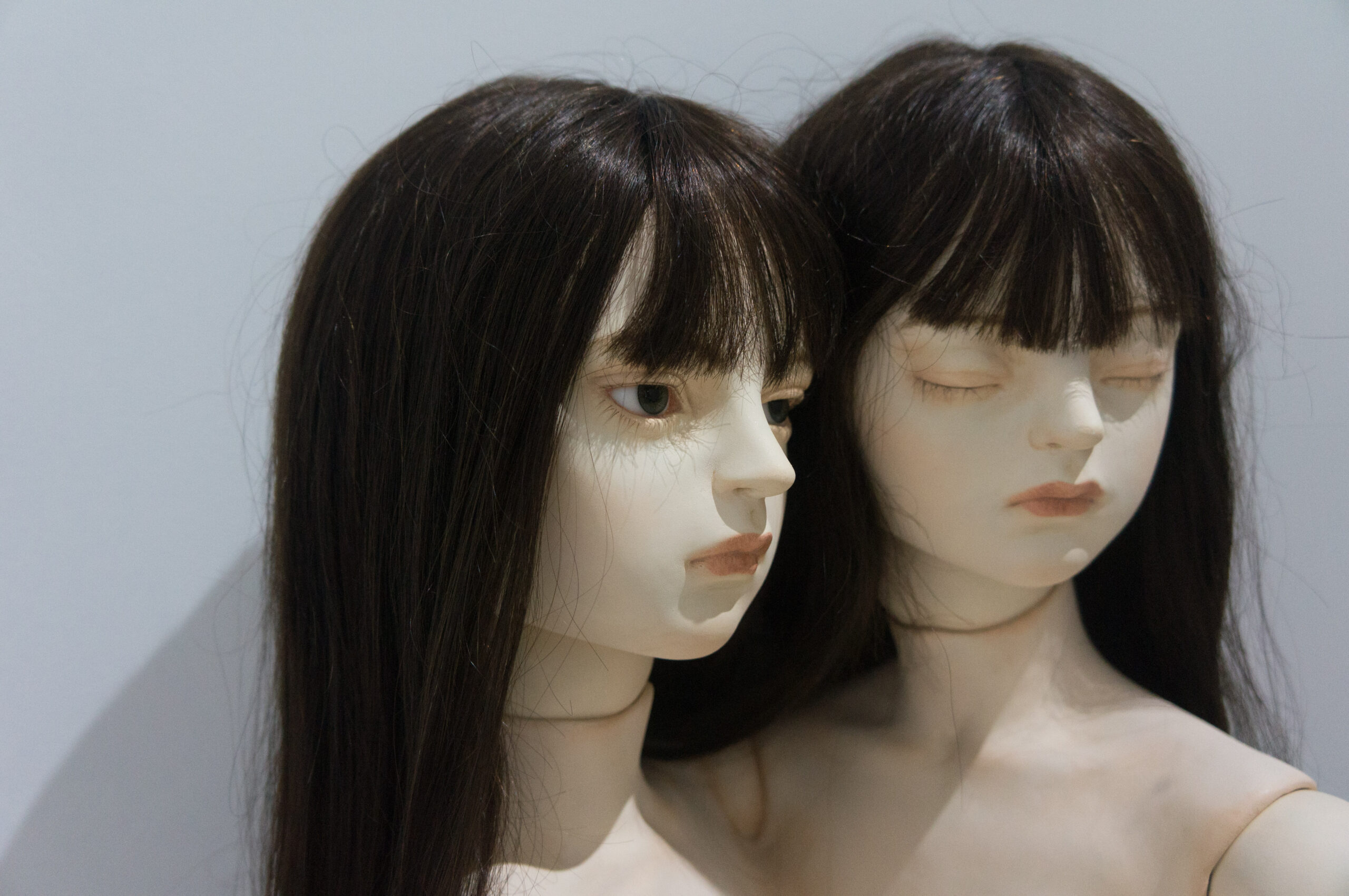A Review by Saito Tsutomu
Originally published in Japanese on note.com
Exhibition: Tokyo Zokei University Graduation Exhibition
Year: 2023
Medium: Stone powder clay, modeling paste, oil paint, and hair
Institution: Tokyo Zokei University, Sculpture Department
Opening Context
When I walked into the furthest sculpture building at Tokyo Zokei University, there was a figure sitting on the floor near the entrance wall that immediately caught my attention: Geppaku no Shiro (Moonwhite Castle) by Sato Raimu.With its two heads sharing one nude body and long hair, this ball-jointed figure had an unsettling quality that made it completely different from the white plaster human figures around it—academic assignment responses displayed on pedestals throughout the 2023 graduation exhibition space.
Tokyo Zokei University’s graduation exhibition represents a crucial threshold where emerging artists establish their voice before entering professional practice. Among conventional sculptural works elevated on institutional supports, Raimu’s piece made bold statement through its ground-level placement, confronting viewers with multiple taboos through its depiction of deformity, nudity, and layers of forbidden beauty while inviting contemplation of fundamental questions about identity, projection, and the relationship between humans and constructed forms.
The Work

Moonwhite Castle is a ball-jointed doll with two heads sharing one nude body from the chest down, with long hair that makes it seem somehow alive in an unsettling way. Positioned directly on the floor at roughly one meter in height, the work establishes an unexpectedly intimate and vulnerable relationship with viewers—neither elevated on pedestal nor protected by institutional framing, but present as if it had simply chosen to rest in this corner.
The materiality proves crucial to the work’s impact. Constructed from stone powder clay and modeling paste, with carefully applied oil paint and human hair, this piece possesses color and texture that creates creature-like vitality blurring boundaries between art object and living entity. The floor placement intensifies this uncanny quality, suggesting the figure might shift position when unobserved, transforming the gallery space into domestic or private realm where such encounters become possible.
The dual faces diverge at chest level: the left face maintains wide-open eyes that seem to peer directly through the viewer, while the right face keeps its eyes peacefully closed in contemplative repose. Looking into those wide-open eyes creates an unsettling feeling—even though I knew this was just a constructed object, the sensation of being watched from ground level, like being evaluated from below, created a kind of psychological tension that elevates the work beyond sculptural presence into psychological territory.
Thematic Analysis
Identity and Multiplicity
The central tension of Moonwhite Castle emerges from its structural duality: one body, two heads. At first, this setup seems to suggest binary opposition, but the shared body creates more of a gradation than a clear division. Where does one identity begin and the other end? The work embodies contemporary literary theorist Hirano Keiichiro’s concept of bunjin (dividual persons)—the idea that individual identity consists of multiple, context-dependent facets rather than unified selfhood, with no central core.
I think this duality might reflect how the “real self” could be more of a construct than it seems. This reminded me of Hirano’s idea that people exist differently in different relationships, like fractions that come together but never achieve wholeness. Standing before the work, the open eye seemed to witness and evaluate while the closed eye appeared to dream and contemplate. Together, they felt like complementary aspects of consciousness that resist any single narrative.
The Empty Vessel and Ghost in the Shell
Like Pierre Huyghe and Philippe Parreno’s collaborative project “No Ghost Just a Shell” (1999-2002)—where they purchased the intellectual property rights to AnnLee, a minor manga character destined for disposal from a Japanese animation company for 46,000 yen—Moonwhite Castle operates as an empty shell awaiting content. The project’s title, drawn directly from Ghost in the Shell, reflects this fundamental concern with the relationship between spirit (ghost) and material form (shell).
However, where AnnLee’s emptiness was distributed among multiple artists who filled her void through various media before her ritual burial, Raimu concentrates this emptiness into singular, physically present form. The ball-jointed construction functions as mechanism for endless interpretation, echoing the Ghost in the Shell universe’s exploration of identity fluidity between mechanical bodies and digitized consciousness.
Cultural Resonance and Human Masks
Within Japanese cultural context, the work connects to both ancient and contemporary practices of human-object projection. The historical connection to hitogata—paper or straw human effigies used in Shinto purification rituals—deepens the work’s cultural resonance, while its ball-jointed construction situates it within Japan’s distinctive creative doll culture where owners develop intimate relationships with articulated figures.
This human-object intimacy gains additional complexity when viewed through Huyghe’s “Untitled (Human Mask)” (2014), where a masked monkey performs human gestures in post-Fukushima ruins. Both works explore the boundaries of human identity through material displacement—Huyghe’s monkey wearing human face and clothing, Raimu’s doll embodying human multiplicity. The mask, in both cases, becomes “a tool for deconstructing the human body and territory,” revealing humanity through strategic concealment.
Critical Evaluation
Raimu succeeds in creating a work that operates simultaneously across multiple categories—sculpture, doll, and conceptual vessel—without compromising the integrity of any single approach. The technical execution demonstrates sophisticated understanding of creative doll construction while maintaining artistic conceptual framework that elevates the work beyond craft object into serious sculptural territory. The decision to place the work directly on the floor instead of on a pedestal completely changes the relationship between viewer and object, making it feel like an accidental encounter rather than a formal museum presentation.
The work’s power lies not in what it represents but in what it enables: a space for projection, contemplation, and recognition of human multiplicity. By combining Japanese creative doll culture’s emphasis on human-object intimacy with contemporary art’s conceptual rigor, Raimu creates hybrid form that challenges both traditional sculpture and conventional doll-making practices while activating the gallery space as domestic environment.
The strategic use of human hair and ball-jointed articulation creates temporal accumulation—the work exists as both static sculpture and potential movement, embodying multiple possibilities simultaneously. This technical innovation serves conceptual purpose, making the work’s thematic concerns about identity and multiplicity physically manifest while the floor placement suggests the figure’s autonomous agency within the space.
Conclusion
Moonwhite Castle shows how contemporary Japanese artists work with themes of identity, projection, and human-object relationships in ways that seem to resonate across different cultures while keeping their specific Japanese cultural depth. Raimu’s sophisticated synthesis of traditional craft techniques, contemporary sculptural practices, and conceptual art frameworks creates a work that functions as both art object and psychological mirror.
The piece succeeds in challenging viewers to confront their own multiplicity through its dual-faced form, while operating within established cultural patterns of human-object intimacy that give the work additional resonance within Japanese artistic context. As both witness and dream, evaluation and contemplation, Moonwhite Castle stands as significant contribution to contemporary discussions about identity, projection, and the constructed nature of selfhood.
In positioning creative doll culture within fine art discourse, Raimu opens new possibilities for understanding how traditional craft practices can inform contemporary artistic investigation, making Moonwhite Castle not merely successful individual work but important bridge between cultural practices often held in artificial separation.
Exhibition: Tokyo Zokei University Graduation Exhibition
Artist: Sato Raimu
Title: Moonwhite Castle
Medium: Stone powder clay, modeling paste, oil paint, and hair
Year: 2023
Reference:
Hirano, Keiichiro. Watashi to wa Nanika: “Kojin” kara “Bunjin” e [What Am I: From “Individual” to “Dividual”]. Tokyo: Kodansha, 2012.
